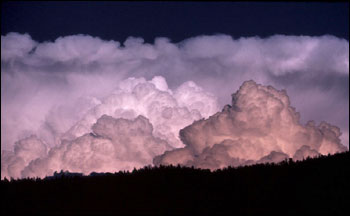clouds
Habitable planets do have their drawbacks. For one, surface conditions near the triple point of water mean that the weather often interferes with differential photometry. That makes it hard for observers in the www.transitsearch.org collaboration to catch planet-bearing stars under clear dark skies during the time windows when transits are predicted to possibly occur!

Such was the case during the March 28, 2006 (06:59 UT) opportunity to check the low-mass red dwarf GL 581 for planetary transits. The planet orbiting GL 581 was announced by the Swiss Planet-hunting team last September (their discovery paper is here). GL 581b is one of the lowest-mass planets known outside our solar system. It’s likely similar in size and composition to Neptune or Uranus, with a minimum mass 17 times that of the Earth. The orbital period is 5.366 days, meaning that the surface temperature should be a bit under the boiling point of water. Tomorrow’s weather forecast for GL581b calls for cloudy skies, humidity near 100%, and afternoon highs near 180 F at the substellar point; the planet almost certainly spins once on its axis for every trip it makes around the star.
GL581 represents an ideal candidate for transitsearch.org observers, and there is no mention in the discovery paper that an attempt was made to check the star for planetary transits prior to the end of last year’s observing season. This lack of a transit check in the discovery paper makes sense, given the planet’s relatively low 3.6% a-priori transit probability, and the 5.366 day orbital period. Without a network of observers spread across the globe, it can take a very long time at a particular spot before one catches a transit window when the sky is (1) clear and (2) dark, and when the star is (3) high overhead. GL581b is a very exciting planet regardless of whether it transits, and so I’m sure Bonfils et al. just wanted to just get their discovery published in the literature. Papers “in prep.” garner no citations. Until Astronomy produces its first commercial killer apps, citations will remain the coin of the realm.

GL 581 is a springtime star, visible from both the Northern and Southern Hemispheres. There was an excellent opportunity last night for California observers to catch the transit, but the Golden State seems to have been clouded out from top to bottom. I have not gotten any reports of observations being made. The next windows of opportunity, and the best viewing sites are:
(1) April 2, 2006 19:04 UT — Japan, Australia
(2) April 8, 2006 00:33 UT — Europe, South Africa
(3) April 13, 2006 09:20 UT — North, South America
The transitsearch.org network has participants in all of these locations, so we should be set.
Boy oh boy would it be a big deal if GL 581b turns out to transit. The occurence of transits would fix the inclination of the planetary orbit, which would eliminate the sin(i) degeneracy that currently plagues the mass estimate. If the planet transits, we would know that it truly has a Neptune mass. The depth of the transit would give us the planetary size, which, coupled with the mass, would yield the density. The density would tell us what the planet is made of. If it is primarily water, like Uranus or Neptune, then we expect a radius of ~0.3 Jupiter radii. If the planet is made of rock and metal, however, like the terrestrial planets in our solar system, then the radius will be smaller, more in the neighborhood of ~0.22 Jupiter radii. A water-rich composition would tell us that the planet formed further away from the star, and then migrated inward to its steamy current location. This information, in turn, would give us valuable insight into the conditions that held sway in the disks surrounding low mass stars, and would help guide our hypotheses regarding the presence of habitable worlds orbiting the lowest mass stars.
Hopefully we’ll snag a transit on April 2nd and then confirm it on April 8th and April 13th. If that happens, I’ll mail a dollar to every registered user of oklo.org. With roulette wheel-like 3.6% odds, I’m not exactly betting the house, but nonetheless, hope springs eternal!
If you are interested in participating in transitsearch.org, feel free to subscribe to the (moderated) transitsearch.org observers list.